The Xiaomi Mi Note Pro and Mi Note Review
by Joshua Ho on September 11, 2015 9:00 AM ESTSystem Performance
Performance may be a rather nebulous thing - there are a number of factors that affect the performance of a smartphone in everyday tasks. One of the single most important components to overall performance is the SoC (System on a Chip). This one package will usually contain the CPU, GPU, DRAM interface, a number of fixed-function blocks, various DSPs, and other processing engines. Usually, DRAM itself is also mounted on top of the SoC package in a package on package (PoP) configuration. In order to test this and more in a smartphone, we rely on a set of benchmarks that are accepted within the industry that can reasonably represent smartphone performance. Of course, the state of the art in benchmarking is always changing, but we can say with reasonable confidence that if a smartphone or tablet performs well in our benchmarks that the SoC will be a good foundation for a smooth experience. Of course, if an OEM then decides to run unoptimized Android UIs on top of this SoC then any performance advantage could be wasted. In the case of the Mi Note, we’re looking at a relatively standard Snapdragon 801 with 3GB of LPDDR3, while the Mi Note Pro uses a more powerful Snapdragon 810 with 4GB of LPDDR4.

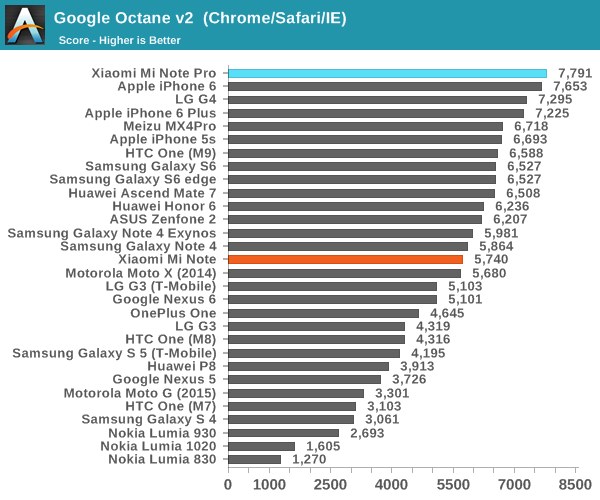
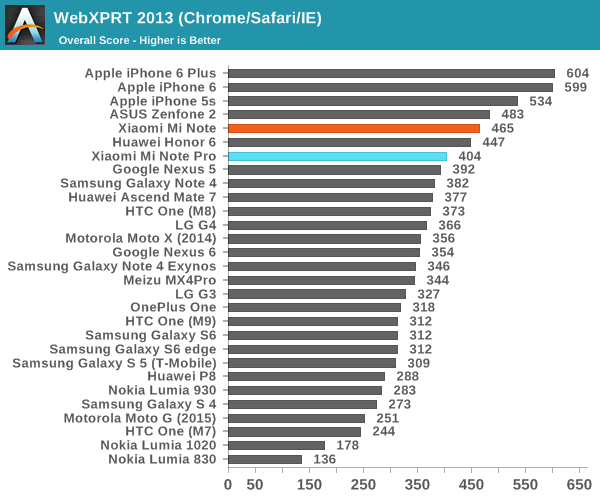
It's interesting to look at these results as we can basically see the differences that result from browser optimizations. It's also important to note here that the Xiaomi Mi Note was run with the Performance mode turned on as otherwise the CPU governor would be far too conservative for good performance. Unfortunately though, it looks like the Performance mode (as opposed to Balanced) is extremely aggressive, setting all cores online and to only use the 2.5 GHz state. Xiaomi needs to provide a more appropriate performance governor for everyday use. It's worth noting here that all benchmarks can be run without the performance governor, but the software will offer to turn it on if it detects a benchmark.
Fortunately, it seems the Mi Note Pro doesn't have these sorts of strange governor settings and performance is in line for what we'd expect from a Snapdragon 810.
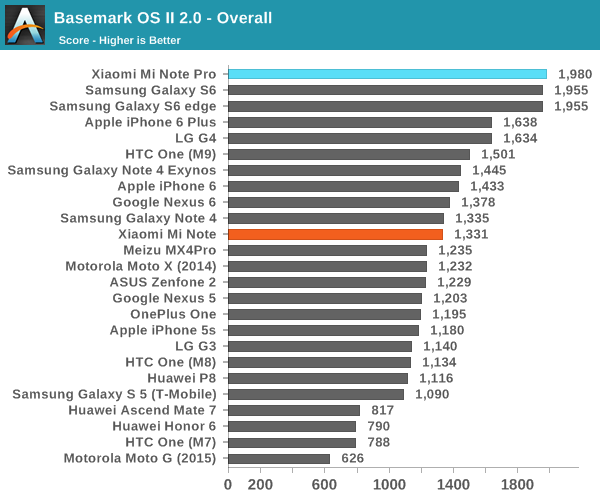
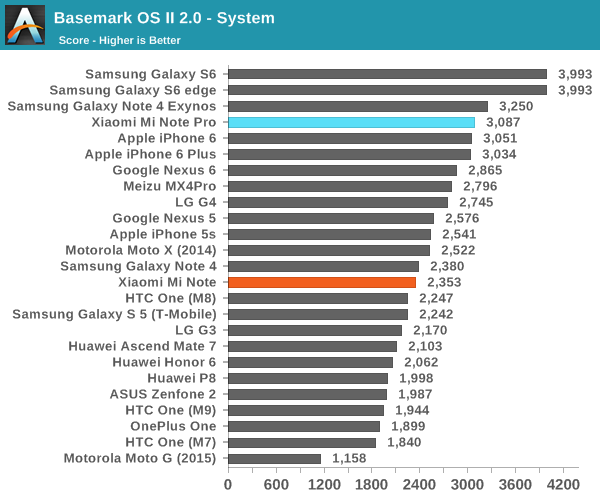

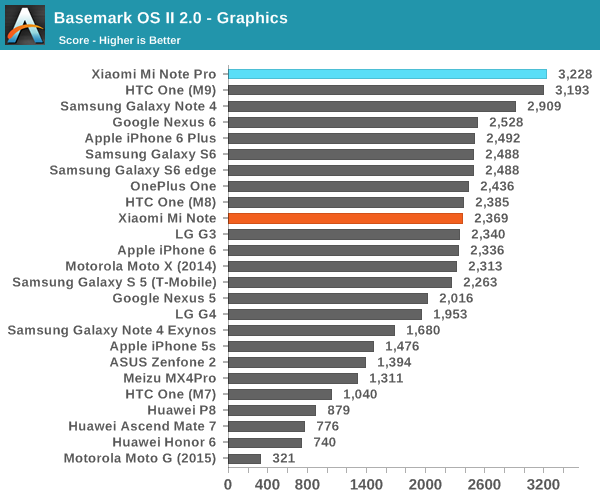
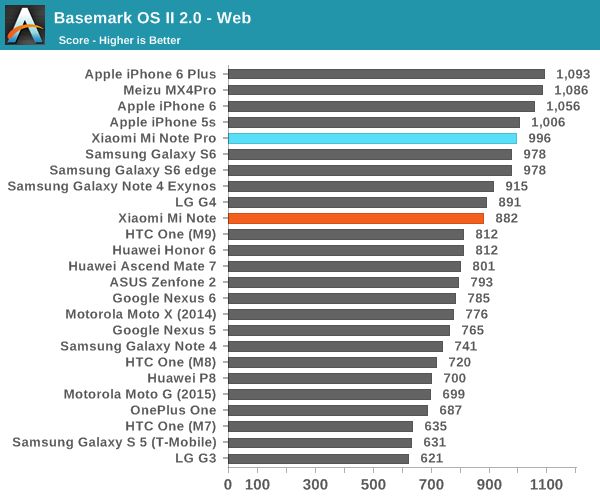
In Basemark OS II we see that performance is roughly estimated to be equal to the Galaxy S6. It seems that most of this is coming from the NAND benchmark aspect and browser optimizations as in the System subtest the Mi Note is around the same level as the Exynos 5433. The graphics subtest shows performance is identical to the One M9, which suggests that the 30 MHz bump in clock isn't going to be particularly helpful.
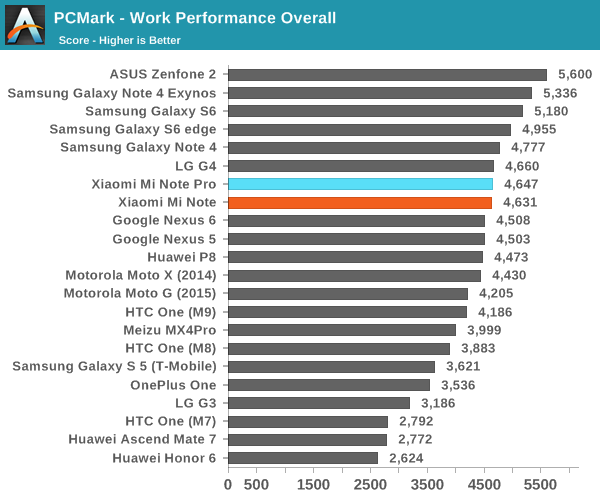
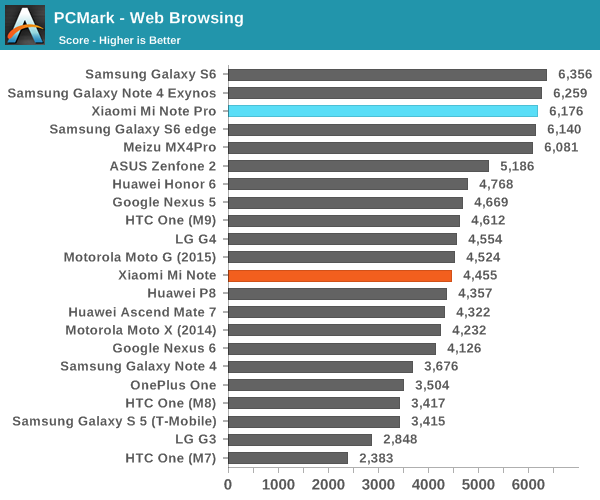
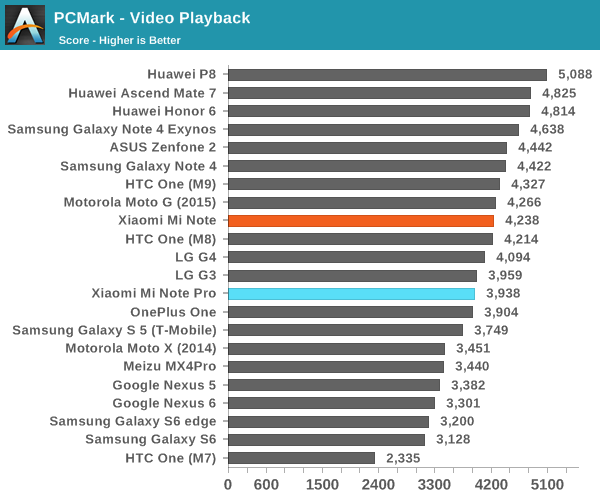
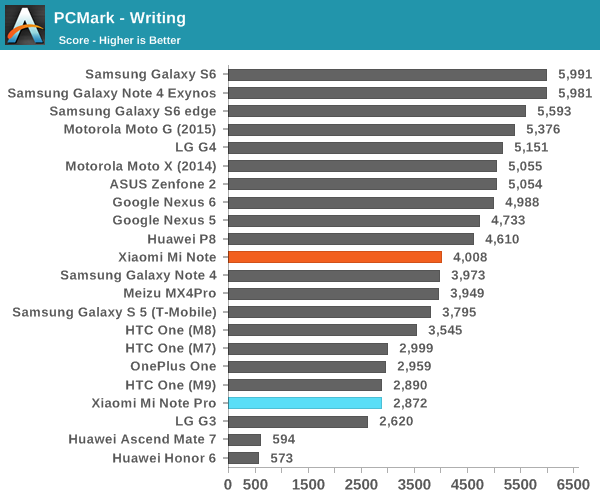
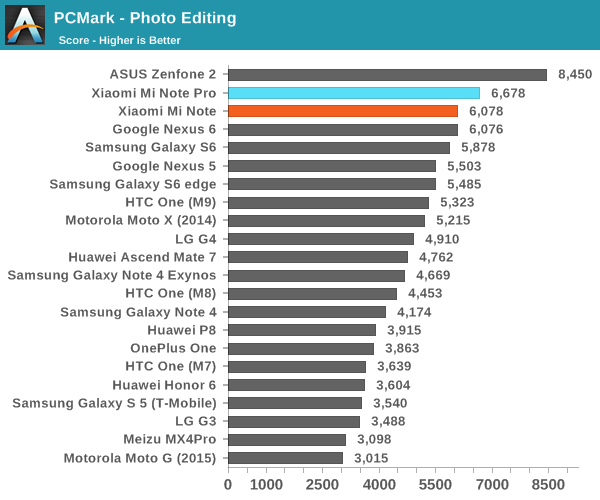
At this point it's pretty fair to say that the Snapdragon 801 is a known quantity when it comes to performance, but when it comes to the Snapdragon 810 it's still in some level of flux. For the Mi Note at least, this is mostly interesting at an academic level as a pure 2.5 GHz 4x Krait comparison relative to the Snapdragon 810. Overall, it looks like the Mi Note Pro is about the same performance as the G4, which makes sense because the governor usually only allows two A57s to stay online in all but the most extreme loads. However, performance has a wide relative variation in cases where the OEM has either invested a lot of time in optimizing their build of Android or not as much. It looks like web browsing is a major point of optimization for the Mi Note Pro as it is competitive with the Galaxy S6 in that test, but in areas like the writing subtest Xiaomi is falling behind somewhat. I suspect this is mostly a software optimization problem as PCMark is extremely sensitive to changes in Android version as seen in the Note 4 and Note 4 Exynos which are surpassing the Mi Note due to an OTA update to Lollipop despite the Mi Note's use of a performance governor.
Overall, performance of Snapdragon 810 in these mostly CPU-bound tasks is acceptable. We can still see some performance gains over Snapdragon 801 and 805 but relative to the Exynos 7420 competition things aren't quite as rosy. Of course, we can talk about software optimization but in Basemark OS II the Mi Note only squeaks by due to a high NAND performance score rather than a strong showing in any SoC performance test. In PCMark we see a similar story of some tests where the Mi Note Pro is doing well, but others where it falls short to give an average score overall. Whatever the case, it's clear that the Mi Note Pro does have a good amount of performance on tap. The Mi Note is also clearly capable of being a strong performer as seen in the performance mode benchmarks, but the balanced governor mode needs to be much better to exploit that performance. Both phones should have enough CPU performance to do pretty much any everyday task.










94 Comments
View All Comments
HanakoIkezawa - Friday, September 11, 2015 - link
Is the note 5 review anytime soon?ddriver - Friday, September 11, 2015 - link
What does the Mi note have to do with a "note"? Does it have a stylus? Or maybe with some other way of taking notes? What makes it a "note"?lilmoe - Friday, September 11, 2015 - link
It's basically an attempt at trolling Samsung really....LoganPowell - Friday, November 27, 2015 - link
But Samsung is the better choice compare to Xiaomi Note, in my opinion and I don't think Xiaomi Note will stand a chance to some of the really good phones that are already available (like http://www.consumerrunner.com/top-10-best-phones/ for example...)mforce - Friday, September 11, 2015 - link
It's the big one :) Chinese phone makers are calling their big phones ( 5.5 or larger ) "Note" while their others aren't really called anything, you'll have plain "Mi4"HanakoIkezawa - Friday, September 11, 2015 - link
They get to piggyback off of samsungs marketing, it's pretty standard fair for Chinese manufacturers.name99 - Saturday, September 12, 2015 - link
It's REALLY hard to feel sorry for anyone piggybacking off Samsung's marketing...snarfbot - Thursday, September 17, 2015 - link
fareJoshHo - Friday, September 11, 2015 - link
It's next.As a sneak peek, if you check some of the still image performance galleries... :)
SAAA - Monday, March 28, 2016 - link
WE HAVE XIAOMI Mi 5 HITTING THE MARKET ON APRIL 6. LOOK OUT DETAILS<a href="http://http://www.upcomingmobile.com/2016/03/giaonee-mi-5... style="color: #b01a38; font-size: 11px;" target="_blank">XIAOMI Mi 5 spec</a>